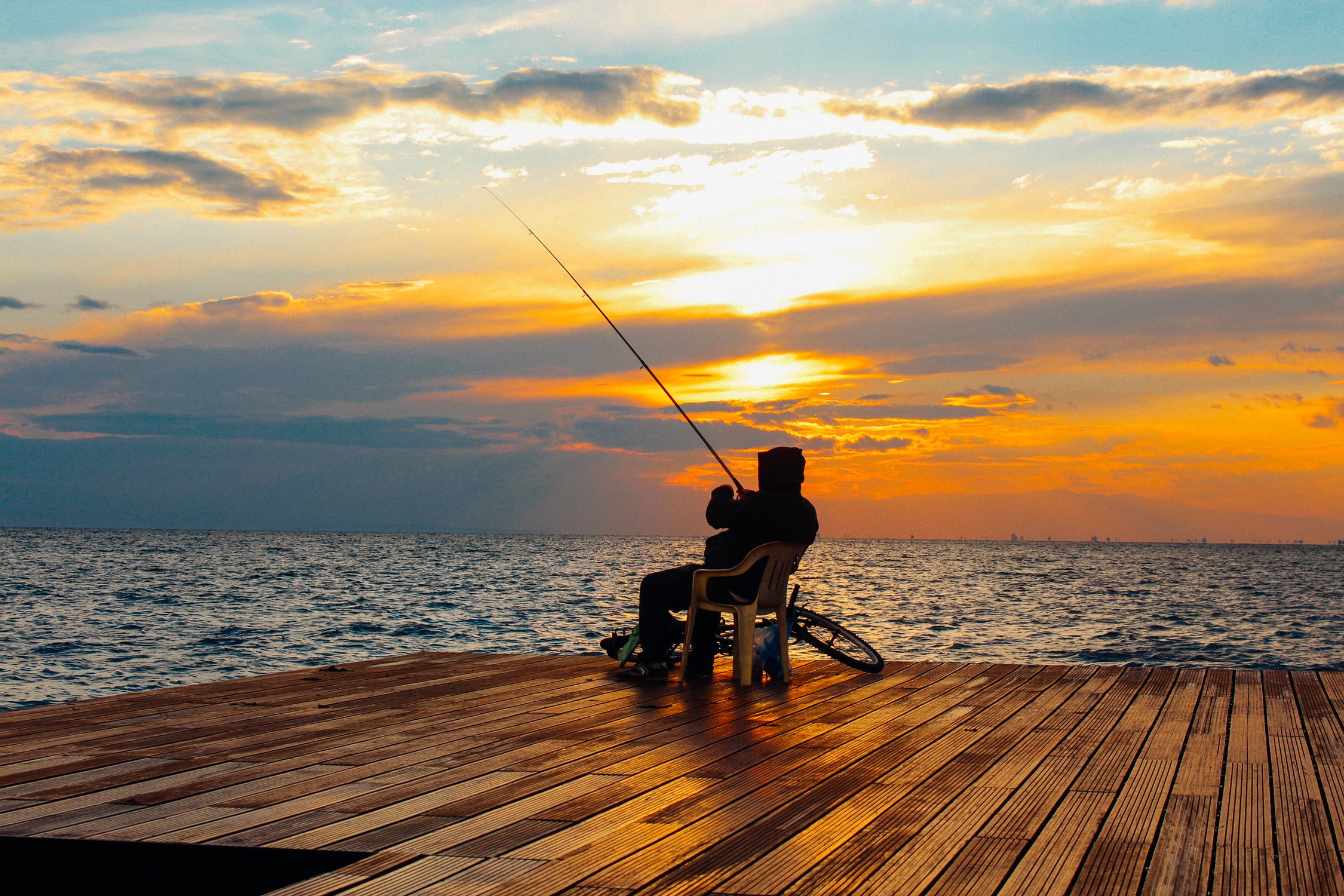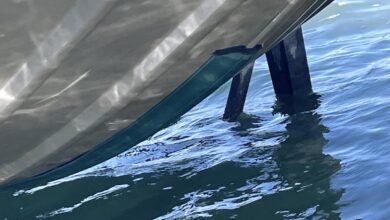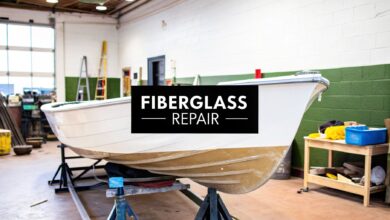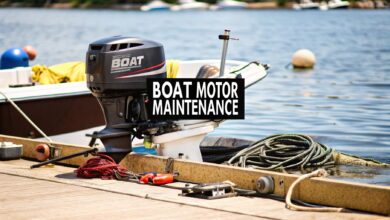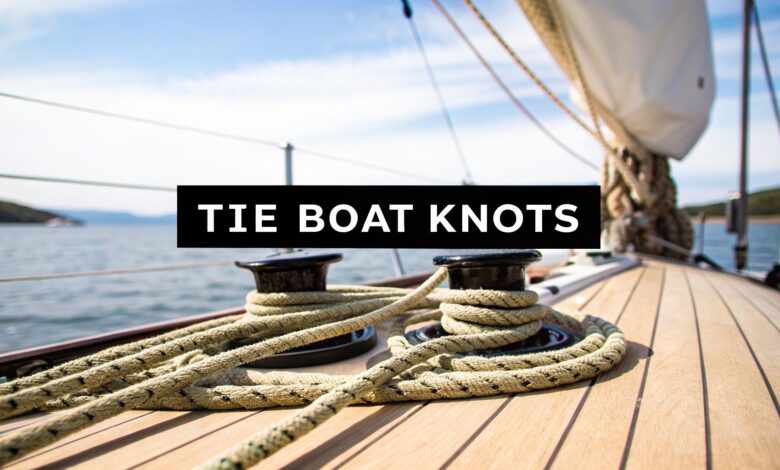
If you're going to master one skill on the water, make it your knots. It’s the single most important thing you can learn to keep your boat safe. This applies whether you're docking for lunch or facing a sudden squall.
This guide isn't about memorizing a hundred obscure knots. It’s about building muscle memory for the essential ones you'll use every time.
Why Knots Are Your Best Friend on the Water
Knowing your knots isn't just an old-school sailor skill. It's the core of safe and efficient boat handling. A properly tied knot is what separates a smooth docking from a very expensive crunch against the pier.
When you know your lines are secure, you handle your boat with more confidence. You react faster and eliminate a huge source of potential accidents.
- Confidence is Key: There's a peace of mind that comes from knowing your boat isn't going anywhere you don't want it to.
- Safety First, Always: A line that comes undone at the wrong moment can quickly turn a calm day into a dangerous one.
- Stop Fumbling, Start Boating: Using the right knot for the right job saves an incredible amount of time and frustration.
The Foundation of Good Seamanship
We’re going to walk through the five knots that are the bedrock of good seamanship. I’ll show you how to tie them and, more importantly, when and why to use each one. This practical knowledge turns a boat owner into a true skipper.
Don't underestimate the importance of this, as poor line handling and bad knots cause trouble. For a great overview, find more resources from the experts at Discover Boating.
The 5 Must-Know Knots at a Glance
Before we dive into the step-by-step instructions, here’s a quick look at the five knots we'll cover. Think of this as your cheat sheet for handling almost any situation.
| Knot Name | Primary Use | Key Benefit |
|---|---|---|
| Cleat Hitch | Securing your boat to a dock cleat. | Fast to tie, easy to adjust, and holds tight. |
| Bowline | Creating a fixed loop at the end of a line. | Extremely reliable; won't slip or jam under load. |
| Clove Hitch | Temporarily tying a line to a piling or rail. | Quick to tie and untie, perfect for short stops. |
| Figure-Eight Knot | Acting as a "stopper" at the end of a line. | Prevents the line from pulling through a block or fairlead. |
| Two Half Hitches | Securing a line to a ring, post, or another rope. | Simple, versatile, and easy to remember. |
Master these five, and you'll be prepared for most situations you'll encounter. Let's get started.
Mastering the Bowline: The King of Knots
If you only learn one knot, make it the Bowline. It’s legendary among sailors and earned its nickname as the "King of Knots." Its genius is creating a fixed loop that will not slip or jam under strain.

The Bowline's importance is proven by its use in rescue operations. U.S. Coast Guard manuals specify it because it won't cinch tight and cause injury. It’s so foundational that most sailors learn it at the start of their training.
To see where it fits with other knots, explore more about essential sailing knots and their uses.
The "Rabbit and the Hole" Method
Ask any old salt how they learned the Bowline, and they'll likely tell you a little story. It's the simplest way to get the muscle memory down.
Think of the standing part of your rope as a tree. First, you form a small overhand loop—this is the "rabbit hole." The working end of your rope is the "rabbit."
- The rabbit pops up through the hole.
- Next, it runs around the back of the tree.
- And finally, the rabbit dives back down into the hole.
Pull everything snug, and you’ve got a perfect, secure Bowline. It's a memorable way to tie one of the most useful knots on the water.
The most common pitfall is having the rabbit go the wrong way around the tree. Always give your finished knot a good tug. The loop shouldn't budge.
How to Tie a Secure Cleat Hitch
Every time you pull up to a dock, you'll need to secure your boat. The Cleat Hitch is the knot you'll use most often, and it's designed for this job. Get it right, and your boat stays put.
The magic of the cleat hitch is its simple, strong pattern. It can handle incredible strain yet unties in a flash when you're ready to cast off.
Tying the Knot, Step-by-Step
First, take your line and make a full wrap around the base of the cleat. Go under both "horns." This initial turn absorbs the main load.
Now, start a figure-eight motion. Cross the line over the top of the cleat and loop it under the opposite horn. Do the same on the other side, crossing over the top again.
To finish, you need to lock the hitch. Make a small loop in the remaining line, flip this loop over, and place it on one of the horns. The free end gets neatly pinched under the final wrap.
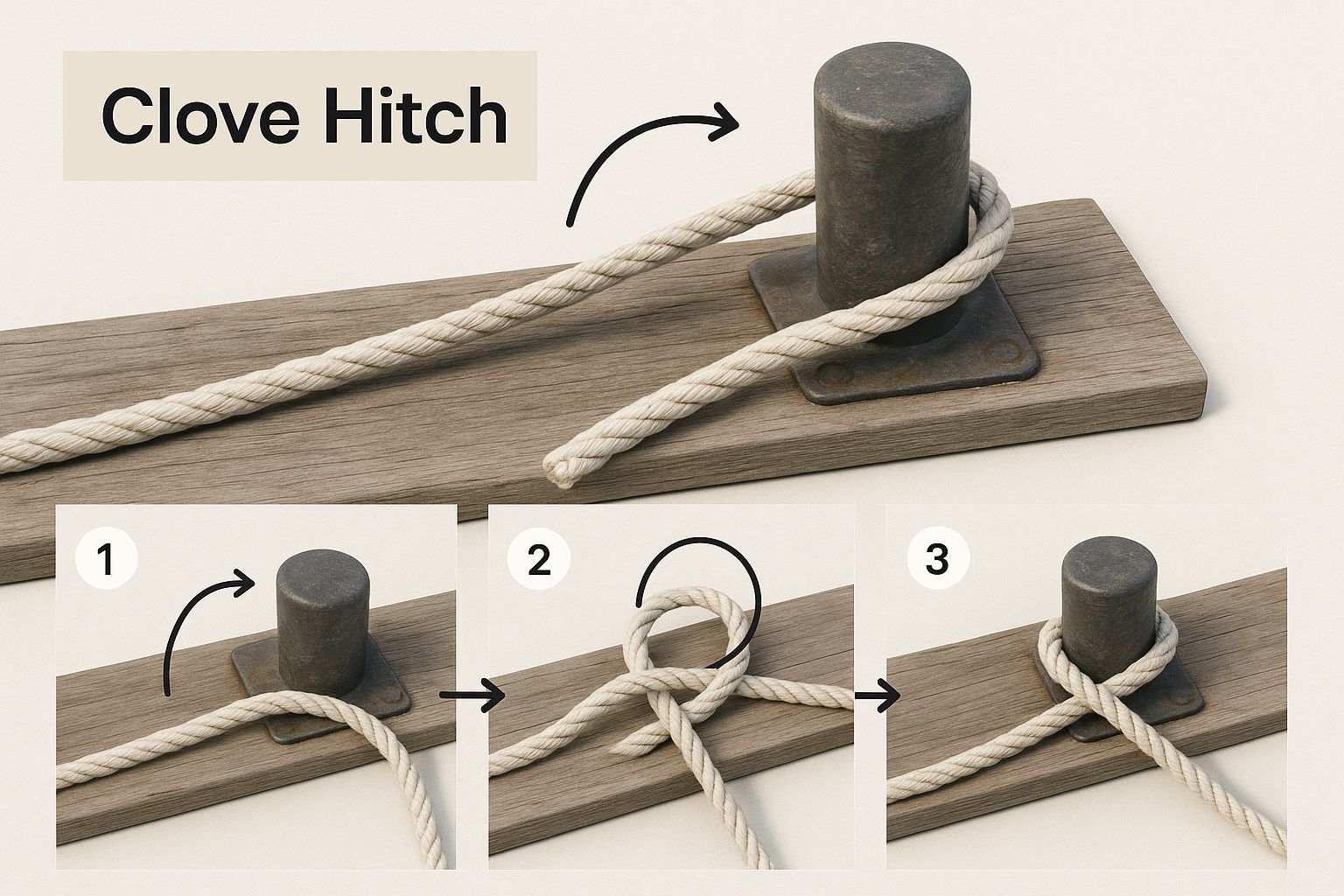
The Clove Hitch is quick, but it can't offer the same peace of mind for mooring your boat. A correctly tied Cleat Hitch can manage thousands of pounds of force without budging. It's worth reading up on the importance of nautical knots to understand why.
Pro Tip: Resist the urge to add extra loops around the cleat. It looks messy, makes the knot weaker, and is harder to untie. One perfectly tied Cleat Hitch is all you need.
Mastering this is just as fundamental as knowing how to anchor your boat correctly. Both are core skills for keeping your boat safe and secure.
The Clove Hitch and Figure Eight Stopper: Your Everyday Workhorses
You'll find yourself using two other knots constantly: the Clove Hitch and the Figure Eight. They're not flashy, but they solve common problems quickly and reliably. These will make your day-to-day boat handling much smoother.
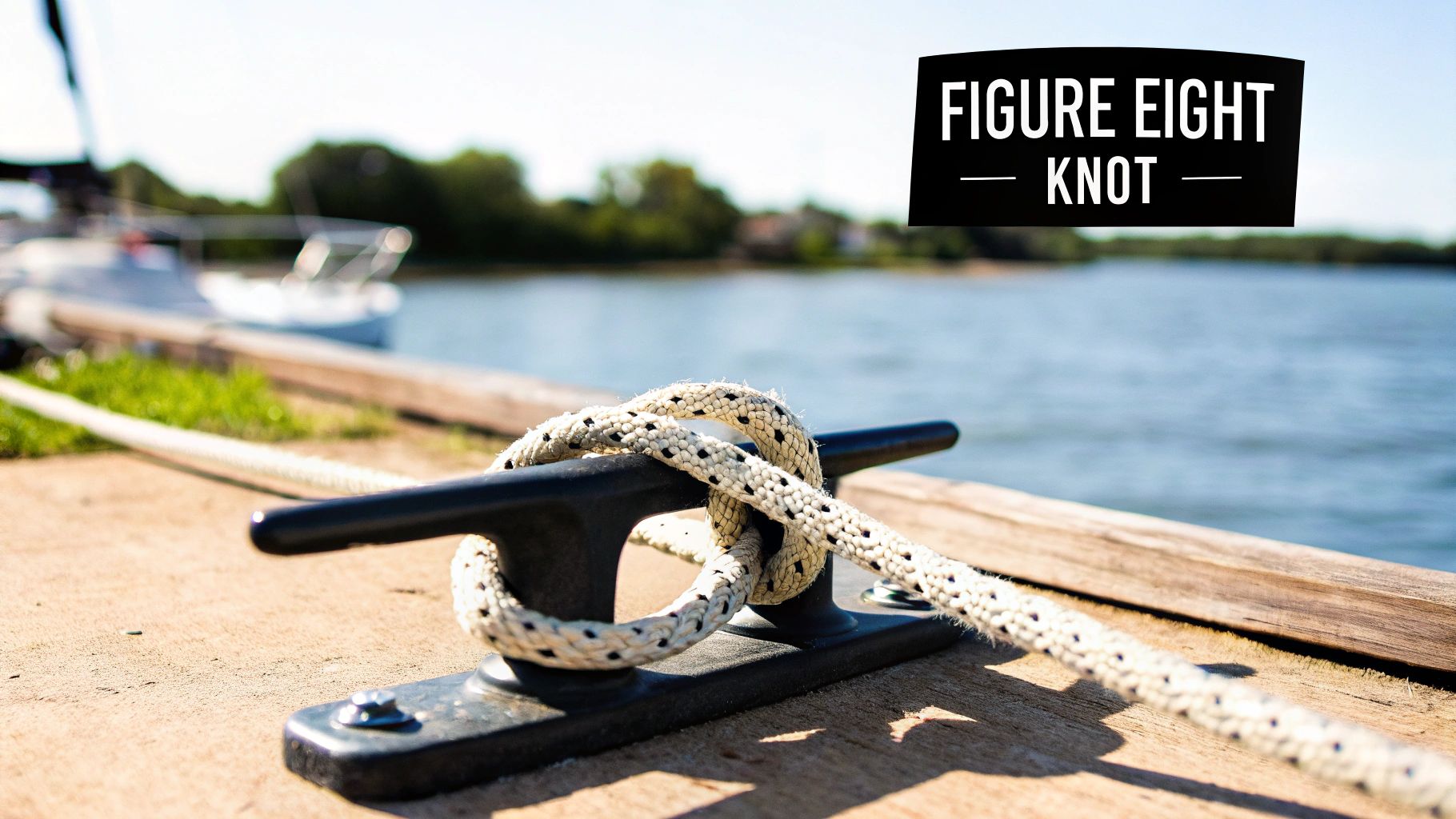
The Clove Hitch is the go-to knot for any quick, temporary job. It's perfect for hanging fenders from a rail or briefly securing a line to a piling. The beauty of it is its speed—it’s lightning-fast to tie and just as easy to undo.
You can tie a Clove Hitch by forming two loops and dropping them over a post. More often, you'll wrap it directly around a rail or piling when you're already alongside.
The Can't-Live-Without-It Stopper Knot
The Figure Eight is all about safety and prevention. Its purpose is to be a reliable "stopper knot." You tie it at the end of a line to stop it from pulling through a block or fairlead.
Don't just tie a simple overhand knot, which can jam up so tight you might have to cut it off. The Figure Eight, thanks to its distinct '8' shape, provides stopping power without cinching down on itself. It always comes undone easily.
Forming it is simple. Pass the tag end of the rope over the standing part to make a loop. Bring the tag end under and around the standing part, then pass it back down through the loop.
These two knots are the unsung heroes of good seamanship. The Figure Eight gives you peace of mind that a critical line won't run free. The Clove Hitch is the quickest way to get fenders set.
Practical Tips for Making Sure Your Knots Actually Hold
Knowing how to form a bowline is one thing; trusting it to hold is another. The real secret to a reliable knot isn't just tying it but how you finish it.
The two most important steps are dressing and setting the knot. Think of it as the final polish that ensures performance.
Dressing a knot is all about making it neat. Smooth out the lines so no strands are twisted or crossing improperly. This detail helps the knot tighten correctly and distribute strain evenly.
Once it looks good, you set it by pulling on all the ends to snug everything down. You’re pre-tightening the knot, removing slack so it can work immediately.
A poorly dressed knot can lose significant strength. It’s worth the extra few seconds to neaten the wraps. This habit prevents dangerous slips.
The Right Rope Makes a World of Difference
Sometimes, the problem isn't you—it's the rope. The type of line you're using impacts how well your knots will hold. A stiff or slippery rope can make even a perfect knot prone to slipping.
- Braided Rope: These lines are a dream to work with. They are softer and more flexible, which helps them grip and hold a knot's shape.
- Three-Strand Rope: This classic is fantastic but can be stiff when new. You just need to work with it a bit to break it in.
If a knot consistently fails, check the line itself before blaming your technique. This point is also covered in our guide on how to tie a boat to a dock.
Common Questions About Tying Boat Knots
https://www.youtube.com/embed/Q9NqGd7464U
Even after you've learned the basics, questions pop up on the water. It’s one thing to tie a knot in your living room. It's another when the wind is picking up and you need a line secure, fast.
Let's dive into some of the most common questions from boaters. Getting these answers down will help you build real confidence.
Why Does My Bowline Knot Sometimes Fail?
If your Bowline comes undone, it was likely tied incorrectly, creating a slip knot. Be precise with the "rabbit and the hole" method. The working end must go back down the same "hole" it came out of.
After tying it, always "dress" the knot by pulling on all four strands of the rope. This ensures everything snugs up tightly and correctly. If it doesn't look right, it probably isn't.
Sometimes, the issue is slick, new rope. For extra peace of mind, add a stopper knot, like a half-hitch, with the tail end around the loop.
Expert Tip: The best way to build muscle memory is consistent practice. Spend 5-10 minutes a few times a week tying your core knots. This is as crucial as knowing the best tips for anchoring on a sandbar.
What Is the Best Knot for Joining Two Ropes?
The "best" knot depends on the ropes you need to join.
-
For connecting two lines of a similar diameter, the Zeppelin Bend is a great choice. It's strong but remains surprisingly easy to untie.
-
For joining ropes of different sizes, the go-to knot is the Sheet Bend. A Double Sheet Bend, which adds an extra wrap, gives you even more security.
Here are a few more common questions we often get from fellow boaters.
| How do I stop a frayed rope end? | The best permanent solution is to use a hot knife to cut and seal the end of a synthetic rope. In a pinch, a Figure-Eight Knot at the end will temporarily stop it from unraveling. |
| Which knot is best for a fender? | A Clove Hitch is the standard for tying fenders to a rail because it's fast and easy to adjust. For more security, you can finish it with a couple of half-hitches. |
| Can I use a Bowline to create a fixed loop in the middle of a line? | No, the Bowline is for the end of a line. For a fixed loop in the middle of a rope, you'll want to learn the Alpine Butterfly Knot. It's a fantastic knot that holds strong. |
Tackling these real-world questions helps you move from just knowing the steps to truly understanding your knots.
At Boating Articles, we're dedicated to giving you the expert guides and practical advice you need to handle every situation on the water with confidence. Explore our extensive resources to make your next trip a safe one. Visit us at Boating Articles to learn more.
